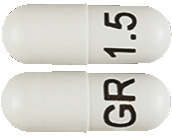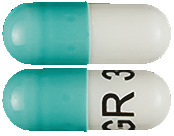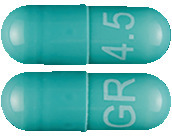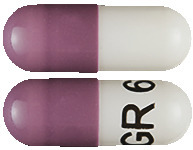SUMMARY CMI
REAGILA®
Consumer Medicine Information (CMI) summary
The full CMI on the next page has more details. If you are worried about using this medicine, speak to your doctor or pharmacist.
▼ This medicine is new or being used differently. Please report side effects. See the full CMI for further details.
1. Why am I using REAGILA®?
REAGILA contains the active ingredient cariprazine. REAGILA is used to treat adults with schizophrenia.
For more information, see Section 1. Why am I using REAGILA®? in the full CMI.
2. What should I know before I use REAGILA®?
Do not use if you have ever had an allergic reaction to REAGILA® or any of the ingredients listed at the end of the CMI.
Talk to your doctor if you have any other medical conditions, take any other medicines, or are pregnant or plan to become pregnant or are breastfeeding. Women of childbearing potential must use effective contraception during and for at least 10 weeks after REAGILA® treatment. REAGILA® is not recommended for use during pregnancy.
For more information, see Section 2. What should I know before I use REAGILA®? in the full CMI.
3. What if I am taking other medicines?
Some medicines should not be taken with REAGILA® as they may interfere with how well it works.
A list of these medicines is in Section 3. What if I am taking other medicines? in the full CMI.
4. How do I use REAGILA®?
- Follow all directions given to you by your doctor or pharmacist carefully. They may differ from the information contained in this leaflet.
More instructions can be found in Section 4. How do I use REAGILA®? in the full CMI.
5. What should I know while using REAGILA®?
| Things you should do |
|
| Things you should not do |
|
| Driving or using machines |
|
| Drinking alcohol |
|
| Looking after your medicine |
|
For more information, see Section 5. What should I know while using REAGILA®? in the full CMI.
6. Are there any side effects?
The most common side effects are restlessness and Parkinsonism. Serious side effects include severe allergic reaction, neuroleptic malignant syndrome, kidney problems, blood clots and suicidal thoughts.
For more information, including what to do if you have any side effects, see Section 6. Are there any side effects? in the full CMI.
▼ This medicine is subject to additional monitoring. This will allow quick identification of new safety information. You can help by reporting any side effects you may get. You can report side effects to your doctor, or directly at www.tga.gov.au/reporting-problems.
FULL CMI
REAGILA® (Ree-ag-ee-la)
Active ingredient: cariprazine
Consumer Medicine Information (CMI)
This leaflet provides important information about using REAGILA®. You should also speak to your doctor or pharmacist if you would like further information or if you have any concerns or questions about using REAGILA®.
Where to find information in this leaflet:
1. Why am I using REAGILA®?
2. What should I know before I use REAGILA®?
3. What if I am taking other medicines?
4. How do I use REAGILA®?
5. What should I know while using REAGILA®?
6. Are there any side effects?
7. Product details
1. Why am I using REAGILA®?
REAGILA® contains the active ingredient cariprazine. REAGILA® is an atypical antipsychotic.
REAGILA® is used to treat adults with schizophrenia.
Schizophrenia is a mental illness characterised by symptoms such as hearing, seeing or sensing things which are not there (hallucination), suspiciousness, mistaken beliefs, incoherent speech and behaviour and emotional flatness.
2. What should I know before I use REAGILA®?
Warnings
Do not use REAGILA® if:
- you are allergic to cariprazine, or any of the ingredients listed at the end of this leaflet.
Always check the ingredients to make sure you can use this medicine. - you are taking any of the medicines listed in Section 3. ‘What if I am taking other medicines?’ as they may interfere with how well Reagila works.
Check with your doctor or pharmacist if you:
- Have or have had any of these medical conditions:
- restlessness and inability to sit still
- abnormal, involuntary movements, most commonly of the tongue or face
- visual impairment
- irregular heart beat or if someone else in your family has a history of irregular heartbeat (including so called QT prolongation seen with ECG monitoring)
- high or low blood pressure, cardiovascular disease
- dizziness on standing up due to a drop in your blood pressure, which may cause fainting
- a history of blood clots, or if someone else in your family has a history of blood clots
- a history of stroke, especially if you are elderly or know that you have other risk factors for stroke
- dementia (loss of memory and other mental abilities) especially if you are elderly
- Parkinson's disease
- diabetes or risk factors for diabetes (e.g. obesity, or someone else in your family has diabetes)
- a history of seizures (fits) or epilepsy - take any medicines for any other condition.
During treatment, you may be at risk of developing certain side effects. It is important you understand these risks and how to monitor for them. See additional information under Section 6. Are there any side effects?
Pregnancy and breastfeeding
Check with your doctor if you are pregnant or intend to become pregnant. REAGILA® is not recommended for use during pregnancy and in women of childbearing potential not using effective contraception.
Women of childbearing potential must use effective contraception during REAGILA® treatment. Even after treatment is stopped, use contraception for at least 10 weeks after your last dose of REAGILA®. This is because the medicine will stay in your body for some time after the last dose was taken.
Ask your doctor about appropriate choices of contraception.
Like most atypical antipsychotic medicines, REAGILA® is not recommended for use during pregnancy. However, if you need to take REAGILA® during your pregnancy, your doctor will discuss with you the benefits and risks of taking it.
If your doctor decides that you should take this medicine during pregnancy, your doctor will monitor your baby closely after birth. This is because the following symptoms may occur in newborn babies of mothers who have used this medicine in the last trimester (last three months) of their pregnancy:
- shaking, muscle stiffness and/or weakness, sleepiness, agitation, breathing problems, and difficulty in feeding.
If your baby develops any of these symptoms, you should contact your doctor.
Breastfeeding is not recommended whilst you are taking this medicine, as it is not known if this medicine can pass in to the breastmilk and affect the baby. Talk to your doctor if you are breastfeeding or intend to breastfeed.
Patients with kidney or liver problems
If you have serious kidney or liver problems REAGILA® may not be appropriate for you. Talk to your doctor.
Elderly patients
Your doctor will carefully select the appropriate dose for your needs. REAGILA® should not be used by elderly patients with dementia (loss of memory).
3. What if I am taking other medicines?
Tell your doctor or pharmacist if you are taking any other medicines, including any medicines, vitamins or supplements that you buy without a prescription from your pharmacy, supermarket or health food shop.
Some medicines should not be taken with REAGILA® as they may interfere with how well it works.
REAGILA® should not be taken with these medicines as they may increase the effect of REAGILA® and you are more likely to get side effects:
- boceprevir, clarithromycin, cobicistat, indinavir, itraconazole, ketoconazole, nefazodone, nelfinavir, posaconazole, ritonavir, saquinavir, telaprevir, telithromycin, voriconazole, diltiazem, erythromycin, fluconazole, verapamil
- Avoid consuming grapefruit juice.
REAGILA® should not be taken with these medicines as it may reduce how well this medicine works:
- carbamazepine, phenobarbital, phenytoin, rifampicin, St. John's wort (Hypericum perforatum), bosentan, efavirenz, etravirine, modafinil, nafcillin
Check with your doctor or pharmacist if you are not sure about what medicines, vitamins or supplements you are taking and if these affect REAGILA®.
4. How do I use REAGILA®?
How much to take
- Always take this medicine exactly as your doctor has told you. Check with your doctor or pharmacist if you are not sure.
- The recommended starting dose is 1.5 mg once a day by mouth. Thereafter, the dose may be slowly adjusted by your doctor, in steps of 1.5 mg, depending on how the treatment works for you.
- The maximum dose should not exceed 6 mg once a day.
- If you were taking another medicine to treat schizophrenia before starting REAGILA®, your doctor will decide whether to stop the other medicine gradually or immediately and how to adjust the dose of REAGILA®. Your doctor will also inform you how to act if you switch from REAGILA® to another medicine
When to take REAGILA®
- REAGILA® should be taken about the same time each day with or without food.
- Swallow REAGILA® whole with a glass of water. Do not chew the capsule.
If you forget to take REAGILA®
REAGILA® should be taken regularly at the same time each day. If you miss your dose at the usual time, take it as soon as you remember it. However, if it is almost time for your next dose, skip the missed dose and continue as usual.
Do not take a double dose to make up for the dose you missed. This may increase the chance of you getting an unwanted side effect.
If you are not sure what to do, ask your doctor or pharmacist.
If you have trouble remembering to take your medicine, ask your pharmacist for some hints.
If you take too much REAGILA®
If you think that you have taken too much REAGILA®, you may need urgent medical attention.
You should immediately:
- phone the Poisons Information Centre
(by calling 13 11 26), or - contact your doctor, or
- go to the Emergency Department at your nearest hospital.
You should do this even if there are no signs of discomfort or poisoning.
5. What should I know while using REAGILA®?
Things you should do
Tell any other doctors, dentists, and pharmacists who are treating you that you are taking REAGILA® if:
- you are about to be started on any new medicines
- you plan to have surgery that needs a general anaesthetic. It may affect other medicines used during surgery.
- you have signs of frequent infections such as fever, chills, sore throat or mouth ulcers
- you have hyperglycaemia (high blood sugar)
- dizziness on standing up, especially when getting up from a sitting or lying position (orthostatic hypotension) or fainting
- you experience weight gain
- you need to have any medical tests while you are taking REAGILA®
- you are about to have any blood tests as it may interfere with the results of some tests. The following can be seen in laboratory tests:
- increases in liver enzymes
- increases in the level of creatine phosphokinase in the blood
- abnormal amount of lipids (e.g. cholesterol and/or fat) in the blood
Call your doctor straight away if you:
- become pregnant while taking REAGILA®
- are having any thoughts or feelings about hurting yourself or to commit suicide. Suicidal thoughts and behaviours are more likely at the beginning of the treatment.
- have combination of confusion, drowsiness, muscle stiffness, high fever, sweating, high blood pressure, fast heartbeat and breathing (these symptoms may be associated with a condition called ‘neuroleptic malignant syndrome’)
Remind any doctor, dentist or pharmacist you visit that you are using REAGILA®.
Things you should not do
- Do not stop using this medicine suddenly.
- Do not give REAGILA® to a child or adolescent under the age of 18 years.
Driving or using machines
Be careful before you drive or use any machines or tools until you know how REAGILA® affects you.
REAGILA® may cause drowsiness, dizziness and vision problems in some people.
Drinking alcohol
Tell your doctor if you drink alcohol.
Avoid alcohol when taking REAGILA®.
Looking after your medicine
- Keep your capsules below 30°C and in the outer carton until it is time to take them in order to protect from light.
Follow the instructions in the carton on how to take care of your medicine properly.
Store it in a cool dry place away from moisture, heat or sunlight; for example, do not store it:
- in the bathroom or near a sink, or
- in the car or on windowsills.
Keep it where young children cannot reach it.
Getting rid of any unwanted medicine
If you no longer need to use this medicine or it is out of date, take it to any pharmacy for safe disposal.
Do not use this medicine after the expiry date.
6. Are there any side effects?
All medicines can have side effects. If you do experience any side effects, most of them are minor and temporary. However, some side effects may need medical attention.
See the information below and, if you need to, ask your doctor or pharmacist if you have any further questions about side effects.
Serious side effects
| Serious side effects | What to do |
Whole body:
| Call your doctor straight away, or go straight to the Emergency Department at your nearest hospital if you notice any of these serious side effects. |
Less serious side effects
| Less serious side effects | What to do |
Nervous system-related:
| Speak to your doctor if you have any of these less serious side effects and they worry you. For eye-related side effects, your doctor will advise you to visit an ophthalmologist. Your doctor will regularly check your weight. |
Tell your doctor or pharmacist if you notice anything else that may be making you feel unwell.
Other side effects not listed here may occur in some people.
Reporting side effects
After you have received medical advice for any side effects you experience, you can report side effects to the Therapeutic Goods Administration online at www.tga.gov.au/reporting-problems. By reporting side effects, you can help provide more information on the safety of this medicine.
Always make sure you speak to your doctor or pharmacist before you decide to stop taking any of your medicines.
7. Product details
This medicine is only available with a doctor's prescription.
What REAGILA® contains
| Active ingredient (main ingredient) | cariprazine |
| Other ingredients (inactive ingredients) | Pregelatinised maize starch Magnesium stearate |
Do not take this medicine if you are allergic to any of these ingredients.
What REAGILA® looks like
REAGILA® 1.5 mg hard capsules (AUST R 325477) are white
REAGILA® 3 mg hard capsules (AUST R 325478) are green and white
REAGILA® 4.5 mg hard capsules (AUST R 325479) are green
REAGILA® 6 mg hard capsules (AUST R 325476) are purple and white
Who Sponsors REAGILA®
Gedeon Richter Australia Pty Ltd
Suite 902 / 15 Blue St
North Sydney NSW 2060
Australia
Who distributes REAGILA®
Seqirus (Australia) Pty Ltd
Melbourne, Victoria
Australia
www.seqirus.com.au
Telephone: 1800 642 865
This leaflet was prepared in November 2023.
Published by MIMS March 2024





 Adverse events reported with the use of Reagila (incidence of 2% or greater) that occurred during pooled schizophrenia studies (safety population) are presented in Table 2.
Adverse events reported with the use of Reagila (incidence of 2% or greater) that occurred during pooled schizophrenia studies (safety population) are presented in Table 2.





